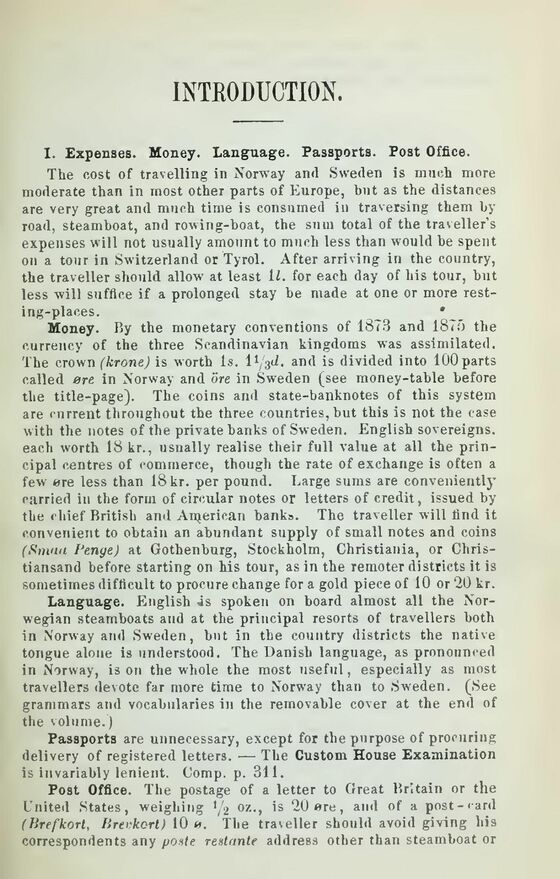
Full resolution (JPEG)
- On this page / på denna sida
- Introduction
- Pages ...

<< prev. page << föreg. sida << >> nästa sida >> next page >>
Below is the raw OCR text
from the above scanned image.
Do you see an error? Proofread the page now!
Här nedan syns maskintolkade texten från faksimilbilden ovan.
Ser du något fel? Korrekturläs sidan nu!
This page has been proofread at least once.
(diff)
(history)
Denna sida har korrekturlästs minst en gång.
(skillnad)
(historik)
INTRODUCTION.
———
I. Expenses. Money. Language. Passports. Post Office.
The cost of travelling in Norway and Sweden is much more
moderate than in most other parts of Europe, hut as the distances
are very great and much time is consumed in traversing them by
road, steamboat, and rowing-boat, the sum total of the traveller’s
expenses will not usually amount to much less than would be spent
on a tour in Switzerland or Tyrol. After arriving in the country,
the traveller should allow at least 11. for each day of his tour, but
less will suffice if a prolonged stay be made at one or more
resting-places. *
Money. By the monetary conventions of 1873 and 1875 the
currency of the three Scandinavian kingdoms was assimilated.
The crown (krone) is worth 1 s. 1 1/3 d. and is divided into 100 parts
called øre in Norway and öre in Sweden (see money-table before
the title-page). The coins and state-banknotes of this system
are current throughout the three countries, but this is not the case
with the notes of the private banks of Sweden. English sovereigns,
each worth 18 kr., usually realise their full value at all the
principal centres of commerce, though the rate of exchange is often a
few ere less than 18 kr. per pound. Large sums are conveniently
carried in the form of circular notes or letters of credit, issued by
the chief British and American banks. The traveller will find it
convenient to obtain an abundant supply of small notes and coins
(Smua Penge) at Gothenburg, Stockholm, Christiania, or
Chris-tiansand before starting on Ms tour, as in the remoter districts it is
sometimes difficult to procure change for a gold piece of 10 or 20 kr.
Language. English is spoken on board almost all the
Norwegian steamboats and at the principal resorts of travellers both
in Norway and Sweden, but in the country districts the native
tongue alone is understood. The Danish language, as pronounced
in Norway, is on the whole the most useful, especially as most
travellers devote far more time to Norway than to Sweden. (See
grammars and vocabularies in the removable cover at the end of
the volume.)
Passports are unnecessary, except for the purpose of procuring
delivery of registered letters. — The Custom House Examination
is invariably lenient. Comp. p. 311.
Post Office. The postage of a letter to Great Britain or the
United States, weighing 1/2 oz., is 20 ere, and of a post-card
(Brefkort, Brevkort) 10 ø. The traveller should avoid giving his
correspondents any poste restante address other than steamboat or
<< prev. page << föreg. sida << >> nästa sida >> next page >>
Project Runeberg, Sat Dec 9 14:19:04 2023
(aronsson)
(diff)
(history)
(download)
<< Previous
Next >>
https://runeberg.org/baenosw89/0019.html



